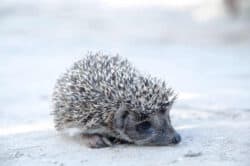Do you want to learn more about the world’s oldest Hedgehog Pet?
You will agree with me that this delightful pet has been increasingly popular over the years, and when I first got one, I kept how long the oldest lived, and since I was inquisitive, I conducted a few studies that were very mind-blowing and interesting, and I would like to share them with you. I’d like to share my thoughts on How Long Do Hedgehog Pet Live, which is my post that will provide you with advice on how to give your buddy a long life.
Here we go,
What Is The Oldest Hedgehog Pet To Ever Live
Thorvald is the name of the world’s oldest hedgehog pet. It was born in Denmark. The female hedgehog had a lifespan of 16 years. It outlived the typical hedgehog’s life expectancy of 9 years, and it’s worth noting that the progeny it produced also outlived the norm. The hedgehog might have lived much longer, but its life was cut short after being attacked by a dog. This finding was achieved by a group of zoologists led by Sophie L. Rasmussen from the University of Oxford, and they succeeded by counting the development lines on the cut of the lower jaws of 388 individuals similar to the growth rings of humans. The calcium metabolism of these animals slows down while they hibernate. As a result, bone development slows or ceases, resulting in the creation of growth lines. As with tree growth rings, one line corresponds to one year. So the scientist was able to determine Torvald’s age at the time of its death.
How To Determine The Age Of Your Hedgehog Pet
Breeders who have experience with hedgehogs know the age of a hedgehog, but this will be tough for newcomers. There are several indicators that can help you know how to calculate the age of a hedgehog especially if you do not have a hedgehog as a pet since it was a baby
The spikes are one of the first things you should look at. The spines of certain species get darker as they age, and this is glaring in European hedgehogs. The hedgehog’s quills become orange, suggesting that it is older. The orange hue of the quills starts changing from the back and spreads as the hedgehog grows older. A hedgehog with most of its quills orange in hue may be getting elderly (in hedgehog years). Kindly bear in mind, that a change in the hue of the quills might suggest a health concern. When you are not sure, take the hedgehog to a professional.
Another indication that your pet is old is the hedgehog’s teeth, which wear down with time. Dental issues are more common in older hedgehog pets. Many vets examine the animal’s teeth to determine its age. Some teeth in an aged hedgehog are mostly not present while others have been removed from usage over a long time period. If you keep a hedgehog as a pet, you must monitor the animal’s oral health. Many illnesses start with symptoms in the teeth, which is a warning sign that anything can be wrong with your pet’s health and can be due to a lack of nourishment.
The small claws on the hedgehog’s foot can also tell us how old your pet is. The hedgehog’s claws reveal information in the same manner as the wear on its teeth does. The claws of aged hedgehogs are frequently shorter and worn.
What Happens When A Hedgehog Pet Gets Older
Knowing how old particular creatures are is difficult, and when it comes to hedgehog pets, it becomes much more difficult. Aging symptoms might include teething issues, Joint deterioration, dementia, or decreased performance of essential organs like kidneys and heart.
Teething issues
These are typical in senior animals. Tartar is a common problem in hedgehogs. This might result in gum irritation and tooth damage. Dental disorders frequently cause discomfort in the mouth, which can be so severe that your pet refuses to eat. If you suspect your hedgehog has an oral issue, you should have him examined by a veterinarian.
Joint deterioration
In aged hedgehogs, joint wear and strain are also prevalent. It is seen more frequently in specific breeds of dogs. This is due in part to hereditary predisposition, but it is also attributable to repeated and incorrect motions, as well as an inadequate diet. Hedgehogs suffering from joint wear are less mobile and may not move as much as they formerly did, and their coat becomes less neat and ruffled.
Dementia or brain aging
The production of free radicals causes harm to the brain. This may result in behavioral changes. Disorientation is one of the symptoms of aging displayed by the hedgehog. It appears to be lost, preoccupied, and disoriented. Sleep habits may be affected as well. They also get unclean and start defecating on themselves.
Decreased performance of heart and kidney
Kidney function declines as hedgehogs age. The symptoms are noticeable when the renal function is less than 30%. Increased water intake and urination, weight loss, lack of appetite, fatigue, vomiting, and poor breath are all possible symptoms. A blood test is then required. If this indicates that the renal function is no longer functioning effectively, steps such as following a diet and potentially taking medication might be done.
Similarly, if your pet’s heart isn’t operating as effectively as it should, symptoms such as weariness, coughing, and emaciation may arise. If you see your hedgehog becoming increasingly fatigued when walking, coughing during activity, or even passing out, do not hesitate to take it to a veterinarian. A variety of easy tests can be performed by your veterinarian to establish whether there is a cardiac condition.
In Human Years, How Old Is My Hedgehog Pet
How old my hedgehog pet was in human years is an intriguing subject. Humans have a significantly slower metabolism than hedgehogs. This means that they will be many years older than us in a matter of months. Hedgehogs may live to be 70 human years old or more from the age of four. The table below will give a better explanation of age calculation
| YEARS OF THE HEDGEHOG | HUMAN YEARS |
| 2 months | 10 years |
| 6 months | 20 years |
| 1 year and a half | 30 years |
| 3 years | 40 years |
| 4 years | 70 years |
| More than 5 years | 80 years and above |
Potential Dangers to Hedgehog’s Pets and How to Avoid Them
Among the many hazards that our mechanical world poses to hedgehogs are the following:
Poisoning by slug repellents and other chemicals may kill around 26% of hedgehog pets directly or indirectly by eating poisoned insects or snails. Use “natural remedies” and slug techniques to protect hedgehogs against intoxication and poisoning.
Drowning after falling into a swimming pool or basin with steep edges that prohibit it from escaping and can kill 10% of hedgehogs despite being a superb swimmer, he becomes spent attempting to get out of the water. To prevent drowning in a pool or pond with steep walls, float a board of wood that will serve as a raft.
Gardening equipment: Hedgehogs are frequently harmed by the blades of brush cutters or lawnmowers. To preserve a natural garden, mow your lawn light because the hedgehog is a semi-nocturnal animal, only mow the utilized areas of the garden and let the rest grow naturally. Check the corners of your garden as well before mowing.
Hedgehogs can also become entangled in the trash or too-wide fence meshes. Keep an eye on the culture nets and make sure no animals are captured in them.
Weasels, badgers, foxes, cats, and dogs are examples of natural predators or domestic animals that can harm your pet. Keep an eye out for holes and other ditches where the hedgehog can no longer escape, making it easy prey for predators.
Conclusion
Determining a hedgehog’s exact age is difficult if you do not have them as a newborn. Some traits like the color of their spikes, and the health of their teeth and claws, can help us learn more about how old they are. There are several types of Hedgehogs. It is necessary to conduct a study and choose the one you can provide precise care for, bond well with, and give a long life. I strongly advise you to read my post on What Hedgehogs Pets Eat And Drink because it will provide you with the best for your pet’s health.

